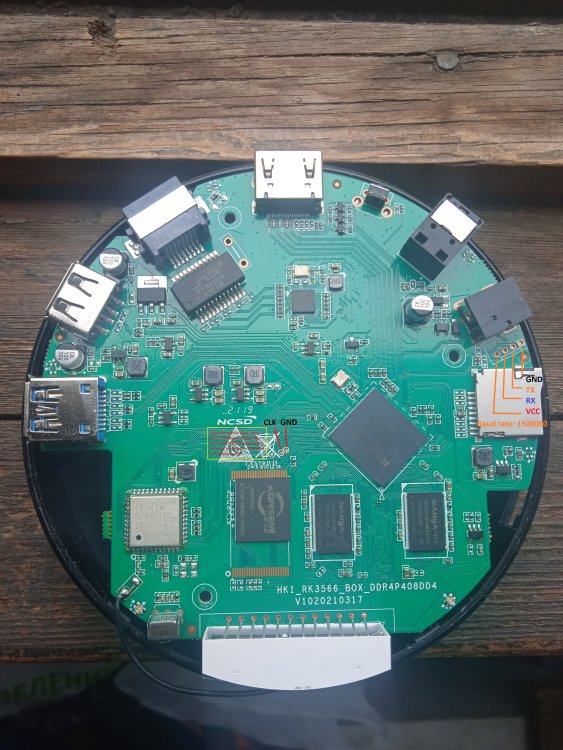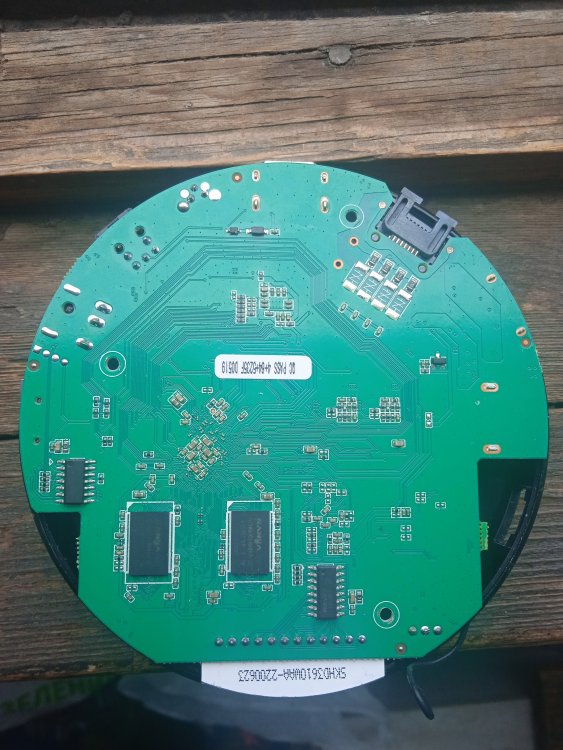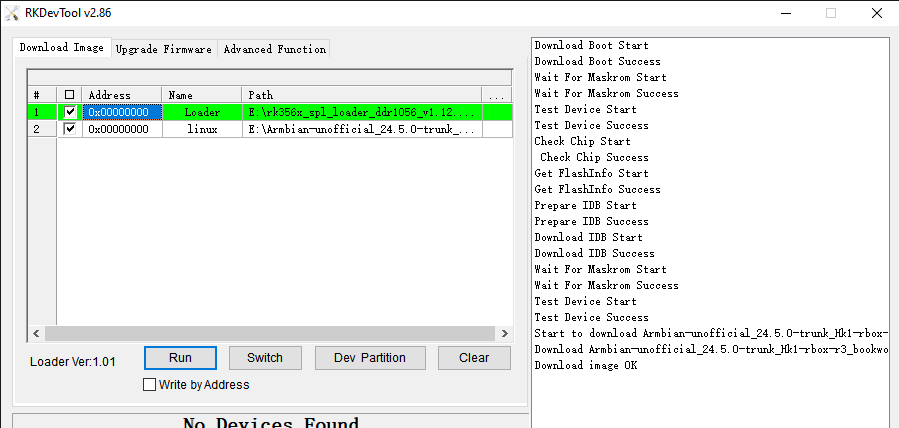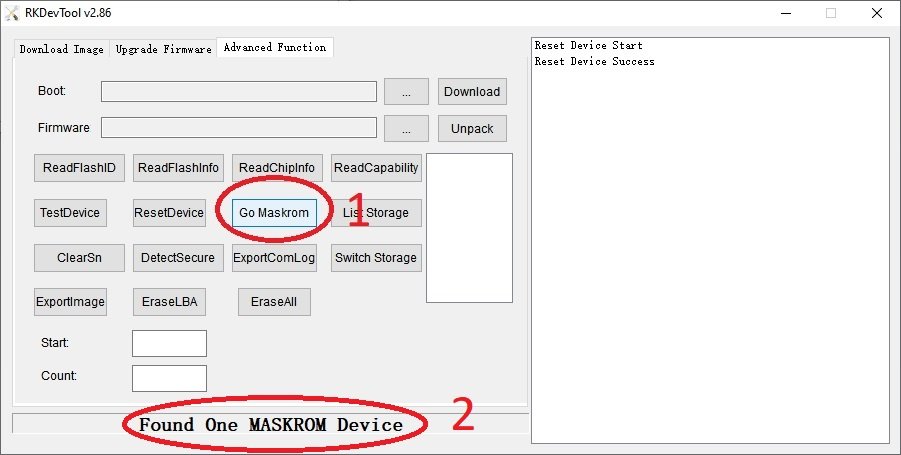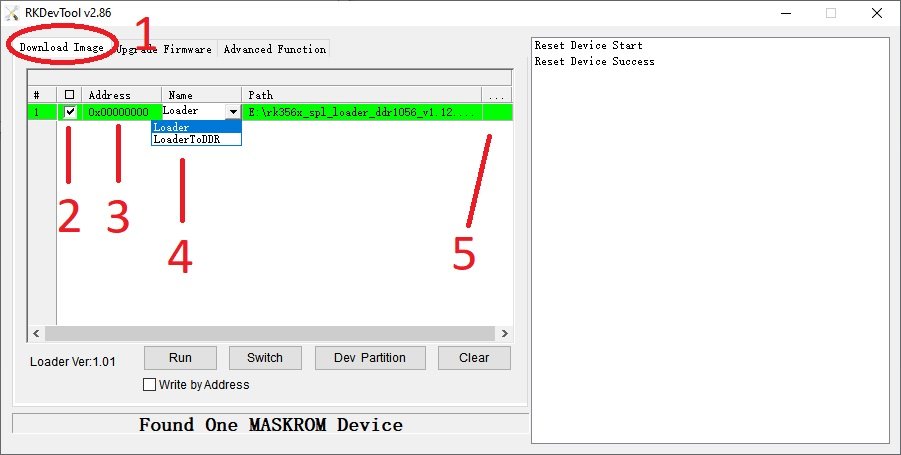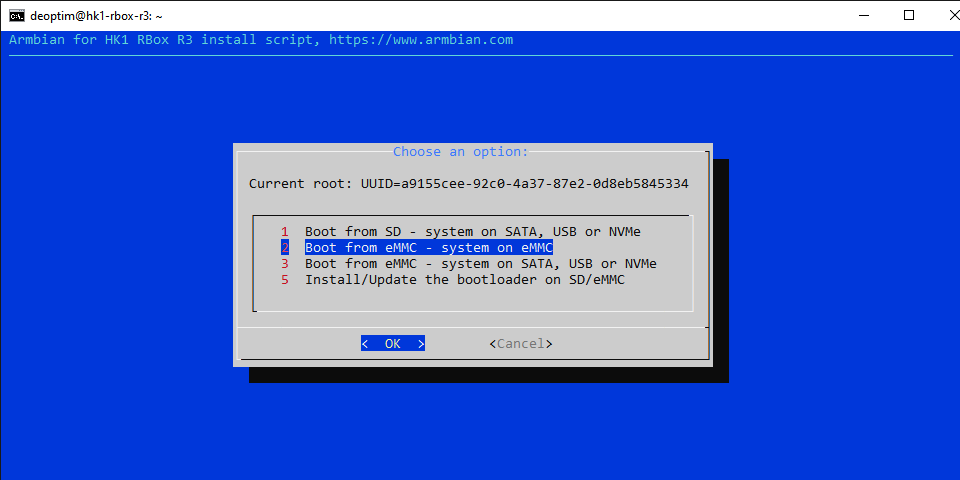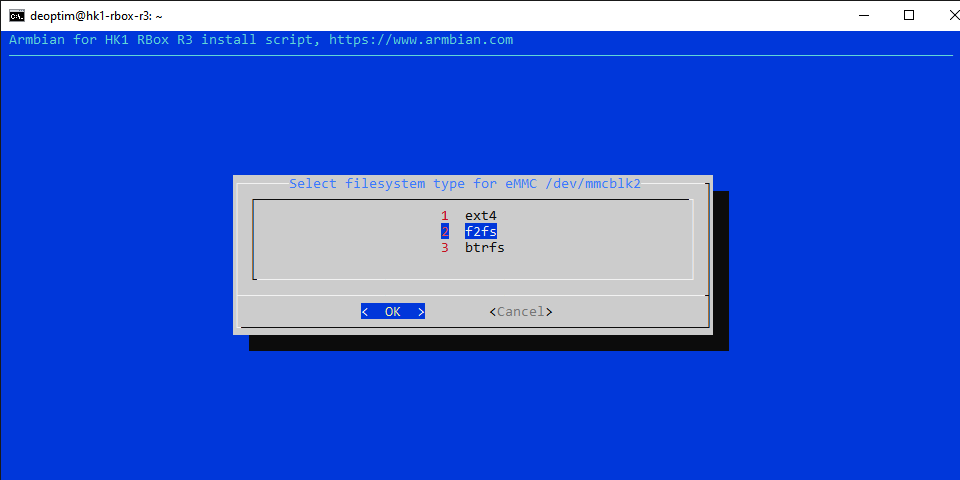Search the Community
Showing results for 'UUID does not exist'.
-
Thank you for taking the time to respond. Will you have the trunk.286 image to download? I looked for it and couldn't find it... the one I have saved is trunk.287. Thank you so much I tried to download it but it does not exist: https://github.com/armbian/os/releases/download/24.5.0-trunk.286/Armbian_24.5.0-trunk.286_Orangepi5_trixie_edge_6.8.1_minimal.img.xz
-
Some months ago I bought a fake Tanix TX3 mini to use as my personal server, but when trying to install armbian I just realized that the real cpu its not a common s90w, as I would expect, but s905l2. Okay, after many tries and helps one a lot of peoples I discovered the right setup for my devide. Ophub armbian fork with 'Armbian_24.5.0_amlogic_s905w_jammy_6.1.84_server_2024.04.08' image with DTB 'meson-gxl-s905l2-ipbs9505' and u-boot-s905x-s912. That is the set up that I did some months ago, but now I bought a higher capacity sdcard (64gb) to store more files. Ok, the sdcard is working, I flashed this image, made the entire set up, but when I try to boot I always get and error that says: 'Gave up waiting for root file system device. ALERT UUID DOES NOT EXISTS'. Then it goes to initramfs. To check it again I tried to use the same set up for my old sdcard (again) and then it worked wonderfully, so I made the conclusion that the problem should be my sdcard. But I read in some post that higher capacity sdcards doest not work very well with Armbian. Should I buy another sdcard or this is a know problem when talking about armbian?
-
shrink-backup is a bash script for backing up your SBC:s into an img file I made this script because I wanted a universal method of backing up my SBC:s into img files as fast as possible (with rsync), no matter what os is in use. shrink-backup Tested on Raspberry Pi os, Armbian, Manjaro-arm and ArchLinuxARM for rpi with ext4 root partition. Autoexpansion will not work on ArchLinuxARM (will not fail, only warn) at the moment but works on the other three tested. Default device that will be backed up unless changed with -d is SD-cards, ie /dev/mmcblk0 Do not forget to make the script executable after downloading it. Usage: sudo shrink-backup -h Script for creating an .img file and subsequently keeing it updated (-B), autoexpansion is enabled by default Directory where .img file is created is automatically excluded in backup ######################################################################## Usage: sudo shrink-backup [-Uatyeldh] imagefile.img [extra space (MB)] -U Update the img file (rsync to existing backup .img), no resizing, -a and -d is disregarded -a Let resize2fs decide minimum space (extra space is ignored), disabled if using -U -t Use exclude.txt in same folder as script to set excluded directories One directory per line: "/dir" or "/dir/*" to only exclude contents -y Disable prompts in script -e DO NOT expand filesystem when image is booted -l Write debug messages in log file shrink-backup.log in same directory as script -d [PATH] EXPERIMENTAL! Use custom device path. default = /dev/mmcblk0 MAXIMUM 2 partitions, more and the script will not function correctly! Feedback on functionality is apreciated (https://github.com/UnconnectedBedna/shrink-backup/discussions) -h --help Show this help snippet ######################################################################## Example: sudo shrink-backup -at /path/to/backup.img Example: sudo shrink-backup -e -y /path/to/backup.img 1000 Example: sudo shrink-backup -Ut /path/to/backup.img Example: sudo shrink-backup -ad /dev/sda /path/to/backup.img Example: sudo shrink-backup -atd /dev/nvme0n1 /path/to/backup.img The folder where the img file is created will ALWAYS be excluded in the backup. If -t option is selected, exclude.txt MUST exist (but can be empty) within the directory where the script is located or the script will exit with an error. Use one directory per line in exclude.txt. /directory/* = create directory but exclude content. /directory = exclude the directory completely. If -t is NOT selected the following folders will be excluded: /lost+found /proc/* /sys/* /dev/* /tmp/* /run/* /mnt/* /media/* /var/swap Rsync WILL cross filesystem boundries, so make sure you exclude external drives unless you want them included in the backup. Use -l to write debug info into shrink-backup.log file in the same directory as the script. Applications used in the script: fdisk (sfdisk) dd parted e2fsck truncate mkfs.ext4 rsync Info: Theoretically the script should work on any device with maximum 2 partitions (boot and root). The script can handle maximum 2 partitions, if there are more than that on root device the script will fail with an error. Even if you forget to disable autoexpansion on a non supported system, the backup will not fail. Custom device part can be set with '-d /dev/xxx'. This function is untested simply because I lack good hardware for proper testing. Feedback on functionality is highly appreciated! If -d is not selected, default device path is used: /dev/mmcblk Order of operations - image creation Reads the block sizes of the partitions Uses dd to create the boot part of the system + a few megabytes to include the filesystem on root (this can be a partition) Removes and recreates the root partition, size depends on options used when starting the script Creates a new ext4 filesystem with the same UUID and LABEL as the system you are backing up from Uses rsync to sync both partitions (if more than one) This means it does not matter if boot is on a partition or f.ex uboot that Armbian uses. Added space is added on top of df reported “used space”, not the size of the partition. Added space is in MB, so if you want to add 1GB, add 1024. The script can be instructed to set the img size by requesting recomended minimum size from e2fsck by using the -a option. This is not the absolute smallest size you can achieve bit is the “safest” way to create a “smallest possible” img file. If you do not increase the size of the filesystem you are backing up too much, you can most likely keep it updated with the update function (-U) of the script. To get the absolute smallest img file possible, do NOT set -a option and set “extra space” to 0 Example: sudo shrink-backup /path/to/backup.img 0 This will instruct the script to get the used space from df and adding 192MB “wiggle room”. If you are like me, doing a lot of testing, rewriting the sd-card multiple times. The extra time it takes each time will add up pretty fast. Example: -rw-r--r-- 1 root root 3.7G Jul 22 21:27 test.img # file created with -a -rw-r--r-- 1 root root 3.3G Jul 22 22:37 test0.img # file created with 0 Disclaimer: Because of how filesystems work, df is never a true representation of what will actually fit on a created img file. Each file, no matter the size, will take up one block of the filesystem, so if you have a LOT of very small files (running docker f.ex) the “0 added space method” might fail during rsync. Increase the 0 a little bit and retry. This also means you have VERY little free space on the img file after creation. If the filesystem you back up from increases in size, an update (-U) of the img file might fail. Order or operations - image update Probes the img file for information about partitions Mounts root partition with an offset for the loop Checks if multiple partitions exists, if true, loops the boot with an offset and mounts it within the root mount Uses rsync to sync both partitions (if more than one) To update an existing img file simply use the -U option and the path to the img file. Changing size in an update is not possible at the moment but is in the todo list for the future. Disclaimer: EEPROM updates might not be backed up in an image update, keep that in mind. To be absolutely sure after doing changes to EEPROM it’s better to make a brand new img rather than updating. As of this moment, there are no plans to include that functionality in the script. To restore a backup, simply “burn” the img file to an sd-card using your favorite method. A backup is not really a backup until you have restored from it.
-
Armbian 24.5.0 Bookworm images (linux-6.1/linux-6.6) for TVBoxes: Vontar KK MAX / HK1 RBOX R2 / HK1 RBOX R3 (the same dts/dtb should work for these TVBoxes) Here is a dts and dtb files, working reworked for mainline: hk1-rbox-r3-profile-kernel-6.1-6.6.zip (original dts and dtb from TVBox rk-kernel-orig.zip) Checked the following: HDMI - works (need to check hot plugging) HDMI sound - works USB 2.0 - works USB 3.0 - works SPDIF - should work (I cannot to check) SD-Card booting and detection - works eMMC install on it (/sbin/nand-sata-install) and detection - works RKDevTool installing and loading images on/from eMMC - works GPU (bugs/frizzes on mainline are not canceled) - works Hardware video acceleration(except for browsers) - works Dualboot if you flash new bootloader (SD-Card boot high priority) - works Here are the compiled Armbian images (Bookworm only) with integrated dtb: https://www.mediafire.com/file/4dwf7ce922x7obq/Armbian-unofficial_24.5.0-trunk_Hk1-rbox-r3_bookworm_current_6.1.87_cinnamon_desktop.img.xz/file https://www.mediafire.com/file/fjwtxb5gjzip341/Armbian-unofficial_24.5.0-trunk_Hk1-rbox-r3_bookworm_current_6.1.87_minimal.img.xz/file https://www.mediafire.com/file/iuz4uijgjh5ry1r/Armbian-unofficial_24.5.0-trunk_Hk1-rbox-r3_bookworm_current_6.6.28_cinnamon_desktop.img.xz/file https://www.mediafire.com/file/kofyqabr5k6qxm8/Armbian-unofficial_24.5.0-trunk_Hk1-rbox-r3_bookworm_current_6.6.28_minimal.img.xz/file The one of this box itself is HK1 RBOX R3, the photo shows the pins for short to go to the Maskrom bootloader and UART pins: A working bootloader(supports dualboot) on this hardware for RKDevTool tool just in case: Loader.zip Please note that RKDevTool flashing utility only needs to flash the .img file with the bootloader, i.e. you need to unpack the .xz archive somewhere first (for ex. you can use 7-zip). -- Recommendations for installation on eMMC ---------------------------------------------------- For those who want to build Armbian themselves, here are the instructions: UPD: Added to images "f2fs-tools" package, added loader to support dualboot without touching the original Android(or other OS) image on eMMC - priority is given to SD-Card. Boot will be from SD-Card if there is on boot partition exist folder and file \boot.scr or extlinux\extlinux.conf - uboot(both: original Android and compiled for Armbian) searches for this path and file if it found this file, it will load from device which contains this file. mmc1(SD-Card) - first, mmc0(eMMC) - second. For correct priority loading it is necessary to replace the main bootloader which is in the archive Loader.zip - if you have an Android it is enough to flash only this bootloader as Loader at 0x0 offset using RKDevTool utility, the rest of the eMMC part should not be touched if the OS and settings we need are there. U-boot on eMMC must be original or Armbian and preinstalled at offset 0x4000. Instructions: (remember, uboot must be on eMMC (even the original Android or Armbian, i.e. if you erase the eMMC - the boot will not work) and this is relevant if you have installed the original MiniLoaderAll.bin, which does not support booting from SD-Card, but only from eMMC. Some TVBoxes may already have a bootloader that supports SD-card booting.). Feel free to test...
-

Helios64 - Armbian 23.08 Bookworm issues (solved)
BipBip1981 replied to ebin-dev's topic in Rockchip
Hi, For moment not crash with my pattern test. Tthis evening i run cpufreq-switching-2-b and post result Keep in touch root@helios64:~# btrfs check --readonly --check-data-csum --progress /dev/disk/by-uuid/1d4e2c84-1c43-4d73-8acb-14d5a7aa1c4d Opening filesystem to check... Checking filesystem on /dev/disk/by-uuid/1d4e2c84-1c43-4d73-8acb-14d5a7aa1c4d UUID: 1d4e2c84-1c43-4d73-8acb-14d5a7aa1c4d [1/7] checking root items (0:04:20 elapsed, 6258640 items checked) [2/7] checking extents (0:22:26 elapsed, 613032 items checked) [3/7] checking free space cache (0:08:50 elapsed, 5519 items checked) [4/7] checking fs roots (8:40:20 elapsed, 169002 items checked) [5/7] checking csums against data (35:54:03 elapsed, 2619191 items checked) helios64@helios64:~$ cat /proc/mdstat Personalities : [raid10] [linear] [multipath] [raid0] [raid1] [raid6] [raid5] [raid4] md0 : active raid10 sdd1[0] sdc1[5] sde1[4] sda1[2] 15627581440 blocks super 1.2 512K chunks 2 near-copies [4/4] [UUUU] [=>...................] check = 5.2% (821480320/15627581440) finish=1681.3min speed=146770K/sec bitmap: 0/117 pages [0KB], 65536KB chunk unused devices: <none> helios64@helios64:~$ uptime 11:05:34 up 1 day, 22:02, 3 users, load average: 2,98, 2,82, 2,78 -

Helios64 u-boot does not build anymore after we bumped to 2022.07
BipBip1981 replied to Igor's topic in Rockchip
Hi, For moment not crash with my pattern test. Tthis evening i run cpufreq-switching-2-b and post result Keep in touch root@helios64:~# btrfs check --readonly --check-data-csum --progress /dev/disk/by-uuid/1d4e2c84-1c43-4d73-8acb-14d5a7aa1c4d Opening filesystem to check... Checking filesystem on /dev/disk/by-uuid/1d4e2c84-1c43-4d73-8acb-14d5a7aa1c4d UUID: 1d4e2c84-1c43-4d73-8acb-14d5a7aa1c4d [1/7] checking root items (0:04:20 elapsed, 6258640 items checked) [2/7] checking extents (0:22:26 elapsed, 613032 items checked) [3/7] checking free space cache (0:08:50 elapsed, 5519 items checked) [4/7] checking fs roots (8:40:20 elapsed, 169002 items checked) [5/7] checking csums against data (35:54:03 elapsed, 2619191 items checked) helios64@helios64:~$ cat /proc/mdstat Personalities : [raid10] [linear] [multipath] [raid0] [raid1] [raid6] [raid5] [raid4] md0 : active raid10 sdd1[0] sdc1[5] sde1[4] sda1[2] 15627581440 blocks super 1.2 512K chunks 2 near-copies [4/4] [UUUU] [=>...................] check = 5.2% (821480320/15627581440) finish=1681.3min speed=146770K/sec bitmap: 0/117 pages [0KB], 65536KB chunk unused devices: <none> helios64@helios64:~$ uptime 11:05:34 up 1 day, 22:02, 3 users, load average: 2,98, 2,82, 2,78 -
I can't boot into the armbian. It hangs at "waiting for a root file system", and repeats the line many times. Then says "Give up waiting for root file system device. Then, " Alert UUID=UUID-number-here does not exist, dropping to shell". It is armbian 24.5 image and dtb file is /dtb/amlogic/meson-sm1-sei610.dtb. I created the u-boot.ext from u-boot-s905x3 file. What I am missing? I tried to stop the autoboot, but it starts with 0 and doesn't even count. Here is the screenshot https://imgur.com/a/9dYm2B9
-

Helios64 - Armbian 23.08 Bookworm issues (solved)
BipBip1981 replied to ebin-dev's topic in Rockchip
Hi, This morning, i do cold boot and crash after few minutes (less than 10min...) Boot is okok but lose ssh connection and to same with usb wire console, i have login and password ask but then i am block... (i can't find if problem hardware... systemd... software...) I use reset bottom and after 15min uptime, i try the same and not lose connection, (i don't understand why not lose connection, i do nothing and Helios64 seem Okok...) i do: (3 times) root@helios64:/tmp# ./cpufreq-switching allocated 64MB test: toggle freq before write 99/100 test: toggle freq before read 9/10, 99/100 root@helios64:/tmp# ./cpufreq-switching allocated 64MB test: toggle freq before write 99/100 test: toggle freq before read 9/10, 99/100 root@helios64:/tmp# ./cpufreq-switching allocated 64MB test: toggle freq before write 99/100 test: toggle freq before read 9/10, 99/100 root@helios64:/tmp# Not crash/freeze and during this test, i have samba Time Machine backup work and lot of I/O Network and 1GO of data pass from my mac to helios. I don't tune voltage, juste use 6.6.28 Kernel and my standard configuaration.... I run again you program and, i have again Time Machine Backup (samba share in background): | | | | ___| (_) ___ ___ / /_ | || | | |_| |/ _ \ | |/ _ \/ __| '_ \| || |_ | _ | __/ | | (_) \__ \ (_) |__ _| |_| |_|\___|_|_|\___/|___/\___/ |_| Welcome to Armbian-unofficial 24.5.0-trunk Bookworm with Linux 6.6.28-current-rockchip64 No end-user support: built from trunk System load: 86% Up time: 27 min Local users: 2 Memory usage: 11% of 3.77G IP: 10.0.0.155 CPU temp: 41°C Usage of /: 47% of 14G RX today: 1.5 GiB [ General system configuration (beta): armbian-config ] Web console: https://helios64:9090/ You have no mail. helios64@helios64:~$ su - Mot de passe : root@helios64:~# cd /tmp/ root@helios64:/tmp# uptime ; ./cpufreq-switching ; uptime 06:34:39 up 28 min, 3 users, load average: 5.87, 4.75, 3.61 allocated 64MB test: toggle freq before write 99/100 test: toggle freq before read 9/10, 99/100 06:36:12 up 29 min, 3 users, load average: 4.99, 4.71, 3.70 root@helios64:/tmp# No Problem, To conclude for moment, to my side; 6.6.28 stable but not at cold boot... stable after. Something (hardware or software) when cold boot crash or do bug in linux software... and after reset buttom is Okok... It's crazy i know ! (Possible problem in cold ramlog boot is /var/log full... i view is full just now... i will investigate next week...) If you want next week, i build a Vanilla armbian from source with official framework and run your cpufreq-switching on it, i think i will have same this day with my standard configuration but maybe not with crash at cold boot If you read my history message about Helios64 since about 3 years... it never stable with standard parameter. I do many tests and to change Kernel and this day the Best Kernel i never use is 6.6.27 and upper because not crash at standard frequency Schedutil Governor The very bad Kernel was 6.X branch, with thing kernel, Helios crash often just when i unlock my raid10 with LUKS cryptosetup And le 5.15.(something)69 or just before was the best stable Kernel with 400-1400Mhz schelutil (i speak about this in very old post) I try again you program, Time Machine Backup is finish... root@helios64:/tmp# uptime ; ./cpufreq-switching ; uptime 06:51:25 up 44 min, 3 users, load average: 3.98, 4.58, 4.24 allocated 64MB test: toggle freq before write 99/100 test: toggle freq before read 9/10, 99/100 06:53:01 up 46 min, 3 users, load average: 3.03, 4.09, 4.10 root@helios64:/tmp# Not crash, now i go to work office and then pass a weekend with my familly, keep in touch next week During this weekend, i run on my helios64 a script do in loop: echo check > /sys/block/md0/md/sync_action and: btrfs check --readonly --check-data-csum --progress /dev/disk/by-uuid/1d4e2c84-1c43-4d73-8acb-XXXXXXXXXXXXXX If Monday morning when i back my Helios64 not crash/freeze, for me 6.6.28 is good Kernel. Have a good day -

Helios64 - Armbian 23.08 Bookworm issues (solved)
BipBip1981 replied to ebin-dev's topic in Rockchip
Hi, My command: To scrub RAID10: echo check > /sys/block/md0/md/sync_action At same time i check BTRFS with: btrfs check --readonly --check-data-csum --progress /dev/disk/by-uuid/1d4e2c84-1c43-4d73-8acb-XXXXXXXXXXXXX At at same time i do copy/delete/copy random from personnal computer to helios64 samba share one pass finished after about 36h... i run pass 3 times For information, i use LUKS overs my raid10 My fancontrol file is: root@helios64:~# cat /etc/fancontrol # Helios64 PWM Fan Control Configuration # Temp source : /dev/thermal-cpu #INTERVAL=10 INTERVAL=30 FCTEMPS=/dev/fan-p6/pwm1=/dev/thermal-cpu/temp1_input /dev/fan-p7/pwm1=/dev/thermal-cpu/temp1_input MINTEMP=/dev/fan-p6/pwm1=40 /dev/fan-p7/pwm1=40 #MAXTEMP=/dev/fan-p6/pwm1=110 /dev/fan-p7/pwm1=110 MAXTEMP=/dev/fan-p6/pwm1=50 /dev/fan-p7/pwm1=50 #MINSTART=/dev/fan-p6/pwm1=60 /dev/fan-p7/pwm1=60 MINSTART=/dev/fan-p6/pwm1=20 /dev/fan-p7/pwm1=20 #MINSTOP=/dev/fan-p6/pwm1=40 /dev/fan-p7/pwm1=40 MINSTOP=/dev/fan-p6/pwm1=20 /dev/fan-p7/pwm1=20 MINPWM=20 and i install: Full Firmware deb package to remove error with 2,5G ethernet driver I do extend swap by swapfile to 6Go and i run 2 containers with podman, Plex and SFTPGO -
@darcyg First let me say that I am no expert on this. I have not tried to compile it lately, but I see that that commit does not longer exist on kwiboo's github. So I don't now if you need to revert to an older version of u-boot. And if you have an EmmC og SPI with u-boot, then it should work to boot from SC card with the new uboot anyway. My log was with debug enabled (and from uart), and I dont have that log anymore. mtty_probe+0x1e8/0x2b0 [sprdbt_tty] So I am not sure the error is the same wireless / bluetooth related error that I got . But I think it is. Make sure that the patch uw5622-fix-adjust-for-rockchip-post-6.1.patch got applied. Take a look in the /output/logs, If you have build the kernel several times it could be using a cached kernel and not included in the log!?, (look in the largest log files). And verify that uw5622-fix-adjust-for-rockchip-post-6.1.patch was included in your compilation: --> (15) INFO: Adding [ Drivers for Unisoc uwe5622 found on some Allwinner and Rockchip boards ] --> (15) INFO: * applying patch/misc/wireless-uwe5622/uwe5622-allwinner.patch --> (15) INFO: * applying patch/misc/wireless-uwe5622/uwe5622-allwinner-bugfix.patch --> (15) INFO: * applying patch/misc/wireless-uwe5622/uwe5622-warnings.patch --> (15) INFO: * applying patch/misc/wireless-uwe5622/uwe5622-park-link-v6.1-post.patch --> (15) INFO: * applying patch/misc/wireless-uwe5622/uwe5622-v6.1.patch --> (15) INFO: * patch/misc/wireless-uwe5622/uwe5622-adjust-for-rockchip-post-6.1.patch --> (15) INFO: * applying patch/misc/wireless-uwe5622/wireless-uwe5622-Fix-compilation-with-6.7-kernel.patch --> (15) INFO: * applying patch/misc/wireless-uwe5622/wireless-uwe5622-reduce-system-load.patch --> (15) INFO: * applying patch/misc/wireless-uwe5622/w-wireless-fix-out-of-tree-build.patch --> (15) INFO: Preparing driver [ driver_rtl8723cs ]
-
https://docs.u-boot.org/en/latest/usage/cmd/env.html Yes I should be able to change the boot-delay of u-boot but it doesn't persist, when I restart the value is gone. I interrupt the boot by hitting any key. Then I do Then I should be able to do but "save" doesn't exist. I will look into how to build/replace this version of U-boot
-
Hello im new and im Italian so i hope you will not hate me if i write not perfectly (Who said Google Translate?? No No No) This Guide is for a "client to client" setup of the box, we will internally switch Wifi to Eth, so a working computer can access internet from its eth port even if the router signal source is wireless. Router AP -----> ARM BOX [WIFI internal or usb dongle] ===>> internal eth0 ------> ethernet cable --> client eth port Make sure WiFi in arm box is connected using nmtui command FROM NOW ON <WIFI CARD> is the wifi adapter name es: replace "<WIFI CARD>" with "wlx0013eff301ee" Execute: sudo apt-get update && sudo apt-get install dnsmasq iptables iptables-persistent -y say no to save actual iptables rules (we dont have any yet) Edit /etc/network/interfaces comment if exist the part of eth0 "iface eth0" to "#iface eth0" add those lines allow-hotplug eth0 iface eth0 inet static address 172.24.1.1 netmask 255.255.255.0 network 172.24.1.0 broadcast 172.24.1.255 dns-nameservers 1.1.1.1 1.0.0.1 #########{Static}########### up ip addr add 172.24.0.1/24 dev eth0 execute those commands REMEMBER TO REPLACE <WIFI CARD> ip addr add 172.24.0.1/24 dev eth0 iptables -A FORWARD -o <WIFI CARD> -i eth0 -s 172.24.0.0/24 -m conntrack --ctstate NEW -j ACCEPT iptables -A FORWARD -m conntrack --ctstate ESTABLISHED,RELATED -j ACCEPT iptables -t nat -F POSTROUTING iptables -t nat -A POSTROUTING -o <WIFI CARD> -j MASQUERADE sh -c "iptables-save > /etc/iptables.ipv4.nat" sh -c "echo 1 > /proc/sys/net/ipv4/ip_forward" /etc/init.d/dnsmasq stop cp /etc/dnsmasq.conf /etc/dnsmasq.conf-backup Edit /etc/dnsmasq.conf inserting interface=eth0 listen-address=172.24.1.1 bind-interfaces server=1.1.1.1 domain-needed bogus-priv dhcp-range=172.24.0.100,172.24.0.250,72h Edit /etc/sysctl.conf inserting net.ipv4.conf.default.forwarding=1 net.ipv4.conf.all.forwarding=1 Edit /etc/rc.local inserting before "exit 0" iptables-restore < /etc/iptables.ipv4.nat execute those commands systemctl enable dnsmasq systemctl enable iptables Explainations: We set static net to eht0 then we set routing in iptables [forward and back] wlan<->eth then we make this setup persistent so that will persist after reboot. Working on my RK3318 Armbian bullseye 5.15 minimal and USB3 dongle RTL8814AU (also tested with a 8812au)
-

Efforts to develop firmware for H96 MAX V56 RK3566 8G/64G
pocosparc replied to Hqnicolas's topic in Rockchip CPU Boxes
@Hqnicolas Nice Job! Sorry I was away for the weekend and I already see that I need to reflash the board. Well I needed to start again with the version 1.2 - I started with Bluetooth and made it work - Although still not sure what is physically written on the chip and how it behaves. I have hcy6335, which in turn should be AP6335 containing the BCM4335 and for Bluetooth BCM4339. Somehow the chip gets represented as hci0: BCM4335A0 (002.001.006) build 0000. I am attaching the hcd file to this post that needs to be copied to the /lib/firmware/brcm. I also changed the dtb for the uart1 as there is no UART1 DMA mode possible otherwise. One just needs to add the dma-names to serial@fe650000 node: serial@fe650000 { compatible = "rockchip,rk3568-uart\0snps,dw-apb-uart"; reg = <0x00 0xfe650000 0x00 0x100>; interrupts = <0x00 0x75 0x04>; clocks = <0x0e 0x11f 0x0e 0x11c>; clock-names = "baudclk\0apb_pclk"; dmas = <0x24 0x02 0x24 0x03>; dma-names = "tx\0rx"; pinctrl-0 = <0x91 0x92 0x93>; pinctrl-names = "default"; reg-io-width = <0x04>; reg-shift = <0x02>; status = "okay"; phandle = <0x10a>; bluetooth { compatible = "brcm,bcm43438-bt"; clocks = <0x94 0x01>; clock-names = "lpo"; device-wakeup-gpios = <0x95 0x11 0x00>; host-wakeup-gpios = <0x95 0x10 0x00>; shutdown-gpios = <0x95 0x0f 0x00>; max-speed = <0x16e360>; pinctrl-names = "default"; pinctrl-0 = <0x96 0x97 0x98>; vbat-supply = <0x23>; vddio-supply = <0x63>; }; }; These are now the dmesg logs that I am getting [ 16.268929] Bluetooth: hci0: BCM: chip id 82 [ 16.269548] Bluetooth: hci0: BCM: features 0x2f [ 16.272162] Bluetooth: hci0: BCM4335A0 [ 16.272173] Bluetooth: hci0: BCM4335A0 (002.001.006) build 0000 [ 16.274413] Bluetooth: hci0: BCM4335A0 'brcm/BCM4335A0.hcd' Patch [ 17.114840] systemd[1]: Finished Armbian memory supported logging. [ 17.152605] systemd[1]: Starting Journal Service... [ 17.299179] systemd[1]: Started Journal Service. [ 17.339995] systemd-journald[632]: Received client request to flush runtime journal. [ 17.369055] Bluetooth: hci0: BCM: features 0x2f [ 17.372008] Bluetooth: hci0: BCM4335B0 JF-LTE MurataXJ AFH_LimitPwr_EDR 2STOPBIT-0343 [ 17.372025] Bluetooth: hci0: BCM4335A0 (002.001.006) build 0353 [ 17.482709] RPC: Registered named UNIX socket transport module. [ 17.482729] RPC: Registered udp transport module. [ 17.482733] RPC: Registered tcp transport module. [ 17.482736] RPC: Registered tcp-with-tls transport module. [ 17.482740] RPC: Registered tcp NFSv4.1 backchannel transport module. [ 18.604874] Bluetooth: BNEP (Ethernet Emulation) ver 1.3 [ 18.604896] Bluetooth: BNEP filters: protocol multicast [ 18.604914] Bluetooth: BNEP socket layer initialized [ 18.647499] Bluetooth: MGMT ver 1.22 ... [ 23.677339] Bluetooth: RFCOMM TTY layer initialized [ 23.677399] Bluetooth: RFCOMM socket layer initialized [ 23.677430] Bluetooth: RFCOMM ver 1.11 h96-tvbox-3566-wifi:~:% hciconfig -a hci0: Type: Primary Bus: UART BD Address: 43:35:B0:07:1F:AC ACL MTU: 1021:8 SCO MTU: 64:1 UP RUNNING RX bytes:4846 acl:0 sco:0 events:556 errors:0 TX bytes:71684 acl:0 sco:0 commands:556 errors:0 Features: 0xbf 0xfe 0xcf 0xff 0xdf 0xff 0x7b 0x87 Packet type: DM1 DM3 DM5 DH1 DH3 DH5 HV1 HV2 HV3 Link policy: RSWITCH SNIFF Link mode: PERIPHERAL ACCEPT Name: 'h96-tvbox-3566-wifi' Class: 0x6c0000 Service Classes: Rendering, Capturing, Audio, Telephony Device Class: Miscellaneous, HCI Version: 4.0 (0x6) Revision: 0x161 LMP Version: 4.0 (0x6) Subversion: 0x4106 Manufacturer: Broadcom Corporation (15) h96-tvbox-3566-wifi:~:% bluetoothctl Agent registered [CHG] Controller 43:35:B0:07:1F:AC Pairable: yes [bluetooth]# show Controller 43:35:B0:07:1F:AC (public) Name: h96-tvbox-3566-wifi Alias: h96-tvbox-3566-wifi Class: 0x006c0000 Powered: yes Discoverable: no DiscoverableTimeout: 0x000000b4 Pairable: yes UUID: A/V Remote Control (0000110e-0000-1000-8000-00805f9b34fb) UUID: Handsfree Audio Gateway (0000111f-0000-1000-8000-00805f9b34fb) UUID: PnP Information (00001200-0000-1000-8000-00805f9b34fb) UUID: Audio Sink (0000110b-0000-1000-8000-00805f9b34fb) UUID: Headset (00001108-0000-1000-8000-00805f9b34fb) UUID: A/V Remote Control Target (0000110c-0000-1000-8000-00805f9b34fb) UUID: Generic Access Profile (00001800-0000-1000-8000-00805f9b34fb) UUID: Audio Source (0000110a-0000-1000-8000-00805f9b34fb) UUID: Generic Attribute Profile (00001801-0000-1000-8000-00805f9b34fb) UUID: Device Information (0000180a-0000-1000-8000-00805f9b34fb) Modalias: usb:v1D6Bp0246d0540 Discovering: no Roles: central Roles: peripheral Advertising Features: ActiveInstances: 0x00 (0) SupportedInstances: 0x05 (5) SupportedIncludes: tx-power SupportedIncludes: appearance SupportedIncludes: local-name [bluetooth]# scan on Discovery started [CHG] Controller 43:35:B0:07:1F:AC Discovering: yes [NEW] Device 4C:BA:D7:02:F5:B7 4C-BA-D7-02-F5-B7 @ning @Hqnicolas UART1 speed is set to max-speed = <1500000>; but according to the datasheet (still no clue if it is the right one) we can go up to 4 MBit/s. Another thing is the schematics that I found somewhere on the internet, but still they are using some AP6xxx wifi/BT chip. Need to dive into this, but hey, now we see the missing components needed for SD-Card slot. Heartbeat is a nice thing, but I will try to enable the backlight blue LEDs, WiFi runniung, and then try to get some HDMI audio out of this thing. BCM4335A0.hcd p562297-AP6335 datasheet_V1.3_02102014.pdf ROC-3566-PC-V10-20210419.pdf -

Upgrade to bookworm failed - system does not start?
bananapinas replied to bananapinas's topic in Amlogic meson
Ok, I repeated the update of bullseye to bookworm. But I did not apt upgrade (only apt update) from the bookworm armbian repository, which installed these packages last time armbian-bsp-cli-odroidn2 armbian-config armbian-zsh base-files linux-dtb-current-meson64 linux-image-current-meson64 linux-u-boot-odroidn2-current Instead I used armbian-config to switch kernels. This also updated the uboot, I think. U-Boot 2022.10-armbian (Feb 23 2024 - 10:32:33 +0000) odroid-n2/n2-plus And now it boots, monitor shows the startup and login does work: ___ _ _ _ _ _ ____ / _ \ __| |_ __ ___ (_) __| | | \ | |___ \ _ | | | |/ _` | '__/ _ \| |/ _` | | \| | __) || |_ | |_| | (_| | | | (_) | | (_| | | |\ |/ __/_ _| \___/ \__,_|_| \___/|_|\__,_| |_| \_|_____||_| Welcome to Armbian 24.2.1 Bookworm with Linux 6.6.16-current-meson64 # lsb_release -a No LSB modules are available. Distributor ID: Debian Description: Armbian 24.2.1 bookworm Release: 12 Codename: bookworm # uname -mrs Linux 6.6.16-current-meson64 aarch64 # cat /etc/debian_version 12.5 Boot log now shows: U-Boot 2022.10-armbian (Feb 23 2024 - 10:32:33 +0000) odroid-n2/n2-plus Model: Hardkernel ODROID-N2 SoC: Amlogic Meson G12B (S922X) Revision 29:c (40:2) DRAM: 3.8 GiB Core: 388 devices, 27 uclasses, devicetree: separate MMC: sd@ffe05000: 0, mmc@ffe07000: 1 Loading Environment from nowhere... OK In: serial Out: serial Err: serial Board variant: n2-plus Net: dwmac_meson8b ethernet@ff3f0000: Can't get reset: -2 eth0: ethernet@ff3f0000 Hit any key to stop autoboot: 0 starting USB... Bus usb@ff500000: Register 3000140 NbrPorts 3 Starting the controller USB XHCI 1.10 scanning bus usb@ff500000 for devices... 3 USB Device(s) found scanning usb for storage devices... 0 Storage Device(s) found Device 0: unknown device switch to partitions #0, OK mmc0 is current device Scanning mmc 0:1... Found U-Boot script /boot/boot.scr 8147 bytes read in 2 ms (3.9 MiB/s) ## Executing script at 08000000 U-boot default fdtfile: amlogic/meson-g12b-odroid-n2-plus.dtb Current variant: n2-plus For variant n2-plus (dash version, 2021.07 or up), set default fdtfile: amlogic/meson-g12b-odroid-n2-plus.dtb 161 bytes read in 2 ms (78.1 KiB/s) Current fdtfile after armbianEnv: amlogic/meson-g12b-odroid-n2-plus.dtb Mainline bootargs: root=UUID=efa55279-3372-4eee-9c23-7b26c477cfb0 rootwait rootfstype=ext4 splash=verbose console=ttyAML0,115200 console=tty1 consoleblank=0 coherent_pool=2M loglevel=1 ubootpart=210296a2-01 libata.force=noncq usb-storage.quirks=0x2537:0x1066:u,0x2537:0x1068:u cgroup_enable=memory swapaccount=1 16364304 bytes read in 698 ms (22.4 MiB/s) 28346880 bytes read in 1208 ms (22.4 MiB/s) 80112 bytes read in 7 ms (10.9 MiB/s) 232 bytes read in 5 ms (44.9 KiB/s) Applying kernel provided DT fixup script (meson-fixup.scr) ## Executing script at 32000000 ## Loading init Ramdisk from Legacy Image at 13000000 ... Image Name: uInitrd Image Type: AArch64 Linux RAMDisk Image (gzip compressed) Data Size: 16364240 Bytes = 15.6 MiB Load Address: 00000000 Entry Point: 00000000 Verifying Checksum ... OK ## Flattened Device Tree blob at 04080000 Booting using the fdt blob at 0x4080000 Loading Ramdisk to 3f064000, end 3ffff2d0 ... OK Loading Device Tree to 000000003efe8000, end 000000003f063fff ... OK Starting kernel ... So everybody - thanks! -
@PLaume Hello! Well, a power loss is a power loss... you won't know what will be gone when the cache is not flushed. I read from the eMCP the code "JY941" or "JY94I", but according to micron part decoder (https://www.micron.com/sales-support/design-tools/fbga-parts-decoder), that chip does not exist. Perhaps it is a fake chinese chip with "micron" printed on it with unknown reliability? About the errors, the hdmi "error" is rather an information and does not affect any feature. The ssv6200 error instead says that the wifi chip does not work because the driver only support ssv6051p chip and not the ssv6256p your board has.
-
Thanks for the quick reply tried it , but got on my running hosts ( debian_12_bookworm_6.6.16-current-sunxi ) --> Failed to disable unit: Unit file armbian-live-patch.service does not exist. I am not aware, that I uninstalled anything like that. my next steps: Let me try with a fresh new image Armbian_24.2.1_Orangepione_bookworm_current_6.6.16.img.xz Update/upgrade online, then go offline and use local repo check every step with I guess " systemctl show armbian-live-patch.service" ?
-
You can put the microsd in your computer and check a few things like is /boot populated? does the UUID of the root partition match in armbianEnv.txt and /etc/fstab?
-
Please help me with the exact same problem with the exact same board, distro, and wifi card. I am very inexperienced with Linux and am having the same problem. Tried installing the firmware manually, tried running apt install armbian-full-firmware, and it ran through the whole rigamarole, but I'm still having trouble. Wifi module isn't in armbian-config, but it is in device list, wifi options are in the GUI, but doesn't find any networks. usr/lib/firmware/iwlwifi-ty-a0-gf-a0.pnvm DOES exist but I don't know how to delete it. Dmesg results in image https://ibb.co/17K58zJ
-

HDMI CEC and Boot Logo on Latest Kernels, Server Image
Hammerill replied to Hammerill's topic in Banana Pi M5
Hello, thank you for trying to help, but this didn't work for me. First, I suppose you wanted to write about the `/boot/dtb/amlogic/` directory, since the `/boot/firmware/` doesn't exist at least on my system. Then, the file we are looking for is probably named `meson-sm1-bananapi-m5.dtb`, so the full command would be `fdtput -t s meson-sm1-bananapi-m5.dtb /aocec status enabled`. But I get this output: $ cd /boot/dtb/amlogic $ fdtput -t s meson-sm1-bananapi-m5.dtb /aocec status enabled Error at '/aocec': FDT_ERR_NOTFOUND `/aocec` is not found. I've even tried to do that on a compiled kernel where I explicitly added all the available CEC modules (AOCEC as a kernel module `*`, all the others are normal modules `M`). Doesn't work. -

Installation Instructions for TV Boxes with Amlogic CPUs
Antonio Ramos replied to SteeMan's topic in FAQ
This tutorial refers the /boot folder but the /boot folder does not exist. Do you mean / instead of /boot ?? Also if i place the sdcard in the sdcard slot it reboots when i press the reset pin but does not show Tanix TX3 , just a blank screen each time it boots. but if i put the sdcard in the usb3 port it reboot and show Tanix T3 each time it reboots. Either way it does not start armbian linux. It always boots to the android. any help ? -
@jock this im not sure ........ can you recommend a image i can just install and then work from there? preferably something that starts out with things not as broken then i can simply configure it and install your patched kernal stuff AFTER? im thinking a fresh install then straight to the patch could be the ticket then ill disable kernel updates straight after, even if it breaks hdmi out as long as it lets me ssh in ill be ok well i installed Armbian-unofficial_24.5.0-trunk_Rk3318-box_bullseye_current_6.6.23_minimal.tar no hdmi output but i could ssh in then i installed your patch. setup the default config stuff now i got a blue led and red no hdmi out still also could not install armbian config or run it as it does not exist for some reason in this build.... its just super confusing as my box is a x 88 pro like everyone else
-

About making really hardware accelleration working with videos with aegisub
SoSie replied to SoSie's topic in Banana Pi M5
I tried with recommanded lxc (linux container is more secure) but opengl Mai is not recognized ----> so instead of sudo mkdir -p /srv/chroot/armbian sudo debootstrap --arch arm64 --foreign bookworm /srv/chroot/debian-arm64 http://debian.xtdv.net/debian sudo schroot -c debian-arm64 (step to create user pi skipped) apt install aegisub inxi We notice EVERYTHING IS RECOGNIZED: (debian-arm64)root@bananapim5:/home/pi# inxi -Gs Graphics: Device-1: meson-g12a-vpu driver: meson_drm v: N/A Device-2: meson-g12a-mali driver: panfrost v: kernel Device-3: meson-g12a-dw-hdmi driver: meson_dw_hdmi v: N/A Display: server: X.Org v: 1.21.1.4 driver: dri: meson gpu: meson_drm,panfrost,meson_dw_hdmi note: X driver n/a resolution: 1920x1080~60Hz API: OpenGL v: 3.1 Mesa 22.3.6 renderer: Mali-G31 (Panfrost) Sensors: System Temperatures: cpu: 44.3 C mobo: N/A Fan Speeds (RPM): N/A ++++++> I have done sudo lxc-create --name "arm64-bookworm" --template download -- --dist debian --release bookworm --arch arm64 sudo lxc-start -n "arm64-bookworm" sudo lxc-attach -n "arm64-bookworm" apt install aegisub inxi We notice GL is not FULLY DETECTED root@arm64-bookworm:/home/pi# inxi -Gs Graphics: Device-1: meson-g12a-vpu driver: meson_drm v: N/A Device-2: meson-g12a-mali driver: panfrost v: kernel Device-3: meson-g12a-dw-hdmi driver: meson_dw_hdmi v: N/A Display: server: X.org v: 1.21.1.7 driver: X: loaded: fbdev,modesetting gpu: mroot@arm64-bookworm:/home/pi# inxi -Gs Graphics: Device-1: meson-g12a-vpu driver: meson_drm v: N/A Device-2: meson-g12a-mali driver: panfrost v: kernel Device-3: meson-g12a-dw-hdmi driver: meson_dw_hdmi v: N/A Display: server: X.org v: 1.21.1.7 driver: X: loaded: fbdev,modesetting gpu: meson_drm,panfrost,meson_dw_hdmi resolution: 1920x1080 API: OpenGL Message: GL data unavailable for root. eson_drm,panfrost,meson_dw_hdmi resolution: 1920x1080 API: OpenGL Message: GL data unavailable for root. root@arm64-bookworm:/home/pi# lshw -c video *-graphics product: mesondrmfb physical id: 5 logical name: /dev/fb0 capabilities: fb configuration: depth=32 resolution=720,480 root@arm64-bookworm:/home/pi# xrandr --listproviders Can't open display :0 The reason is OpenGL rely on Xorg and Xorg can't find my display event after doing export DISPLAY=:0 the device :dev/fb0 does not exist also.as we can seet it withe the Xorg log: root@arm64-bookworm:/home/pi# cat /var/log/Xorg.0.log [ 25980.096] X.Org X Server 1.21.1.7 X Protocol Version 11, Revision 0 [ 25980.096] Current Operating System: Linux arm64-bookworm 6.2.0-rc3-meson64 #23.02.2 SMP PREEMPT Fri Feb 17 23:06:22 UTC 2023 aarch64 [ 25980.096] Kernel command line: root=UUID=4cc9d1be-c592-4e80-8f1c-e73b8c044930 rootwait rootfstype=ext4 splash plymouth.ignore-serial-consoles console=ttyAML0,115200 console=tty1 consoleblank=0 coherent_pool=2M loglevel=1 ubootpart=7ac72bfa-01 libata.force=noncq usb-storage.quirks=0x2537:0x1066:u,0x2537:0x1068:u,0x1058:0x1001:u video=drm_kms_helper.edid_firmware=HDMI-A-1:edid/720x480.bin video=HDMI-A-1:720x480M@60 fbcon=rotate:0 module_blacklist=simpledrm cgroup_enable=memory swapaccount=1 [ 25980.096] xorg-server 2:21.1.7-3+deb12u5 (https://www.debian.org/support) [ 25980.096] Current version of pixman: 0.42.2 [ 25980.097] Before reporting problems, check http://wiki.x.org to make sure that you have the latest version. [ 25980.097] Markers: (--) probed, (**) from config file, (==) default setting, (++) from command line, (!!) notice, (II) informational, (WW) warning, (EE) error, (NI) not implemented, (??) unknown. [ 25980.097] (==) Log file: "/var/log/Xorg.0.log", Time: Sun Mar 17 20:03:34 2024 [ 25980.098] (==) Using config directory: "/etc/X11/xorg.conf.d" [ 25980.098] (==) Using system config directory "/usr/share/X11/xorg.conf.d" [ 25980.100] (==) ServerLayout "dummy_layout" [ 25980.100] (**) |-->Screen "dummy_screen" (0) [ 25980.100] (**) | |-->Monitor "dummy_monitor" [ 25980.101] (**) | |-->Device "dummy_videocard" [ 25980.101] (**) |-->Input Device "dummy_mouse" [ 25980.101] (**) |-->Input Device "dummy_keyboard" [ 25980.101] (==) Automatically adding devices [ 25980.101] (==) Automatically enabling devices [ 25980.101] (==) Automatically adding GPU devices [ 25980.101] (==) Automatically binding GPU devices [ 25980.101] (==) Max clients allowed: 256, resource mask: 0x1fffff [ 25980.101] (WW) The directory "/usr/share/fonts/X11/cyrillic" does not exist. [ 25980.101] Entry deleted from font path. [ 25980.101] (==) FontPath set to: /usr/share/fonts/X11/misc, /usr/share/fonts/X11/100dpi/:unscaled, /usr/share/fonts/X11/75dpi/:unscaled, /usr/share/fonts/X11/Type1, /usr/share/fonts/X11/100dpi, /usr/share/fonts/X11/75dpi, built-ins [ 25980.101] (==) ModulePath set to "/usr/lib/xorg/modules" [ 25980.101] (II) Loader magic: 0xaaaac1da0f00 [ 25980.101] (II) Module ABI versions: [ 25980.101] X.Org ANSI C Emulation: 0.4 [ 25980.101] X.Org Video Driver: 25.2 [ 25980.101] X.Org XInput driver : 24.4 [ 25980.101] X.Org Server Extension : 10.0 [ 25980.105] (EE) systemd-logind: failed to get session: PID 991 does not belong to any known session [ 25980.109] (II) xfree86: Adding drm device (/dev/dri/card0) [ 25980.109] (II) Platform probe for /sys/devices/platform/soc/ff900000.vpu/drm/card0 [ 25980.111] (II) xfree86: Adding drm device (/dev/dri/card1) [ 25980.111] (II) Platform probe for /sys/devices/platform/soc/ffe40000.gpu/drm/card1 [ 25980.111] (II) no primary bus or device found [ 25980.111] (II) LoadModule: "glx" [ 25980.112] (II) Loading /usr/lib/xorg/modules/extensions/libglx.so [ 25980.115] (II) Module glx: vendor="X.Org Foundation" [ 25980.116] compiled for 1.21.1.7, module version = 1.0.0 [ 25980.116] ABI class: X.Org Server Extension, version 10.0 [ 25980.116] (==) Matched modesetting as autoconfigured driver 0 [ 25980.116] (==) Matched fbdev as autoconfigured driver 1 [ 25980.116] (==) Assigned the driver to the xf86ConfigLayout [ 25980.116] (II) LoadModule: "modesetting" [ 25980.116] (II) Loading /usr/lib/xorg/modules/drivers/modesetting_drv.so [ 25980.117] (II) Module modesetting: vendor="X.Org Foundation" [ 25980.117] compiled for 1.21.1.7, module version = 1.21.1 [ 25980.117] Module class: X.Org Video Driver [ 25980.117] ABI class: X.Org Video Driver, version 25.2 [ 25980.117] (II) LoadModule: "fbdev" [ 25980.117] (II) Loading /usr/lib/xorg/modules/drivers/fbdev_drv.so [ 25980.117] (II) Module fbdev: vendor="X.Org Foundation" [ 25980.118] compiled for 1.21.1.3, module version = 0.5.0 [ 25980.118] Module class: X.Org Video Driver [ 25980.118] ABI class: X.Org Video Driver, version 25.2 [ 25980.118] (II) LoadModule: "void" [ 25980.118] (WW) Warning, couldn't open module void [ 25980.118] (EE) Failed to load module "void" (module does not exist, 0) [ 25980.118] (II) modesetting: Driver for Modesetting Kernel Drivers: kms [ 25980.118] (II) FBDEV: driver for framebuffer: fbdev [ 25980.119] (WW) Falling back to old probe method for modesetting [ 25980.119] (EE) open /dev/dri/card0: No such file or directory [ 25980.119] (WW) Falling back to old probe method for fbdev [ 25980.119] (II) Loading sub module "fbdevhw" [ 25980.119] (II) LoadModule: "fbdevhw" [ 25980.119] (II) Loading /usr/lib/xorg/modules/libfbdevhw.so [ 25980.119] (II) Module fbdevhw: vendor="X.Org Foundation" [ 25980.119] compiled for 1.21.1.7, module version = 0.0.2 [ 25980.119] ABI class: X.Org Video Driver, version 25.2 [ 25980.120] (EE) open /dev/fb0: No such file or directory [ 25980.120] (WW) Falling back to old probe method for modesetting [ 25980.120] (EE) open /dev/dri/card0: No such file or directory [ 25980.120] (WW) Falling back to old probe method for fbdev [ 25980.120] (II) Loading sub module "fbdevhw" [ 25980.120] (II) LoadModule: "fbdevhw" [ 25980.120] (II) Loading /usr/lib/xorg/modules/libfbdevhw.so [ 25980.120] (II) Module fbdevhw: vendor="X.Org Foundation" [ 25980.120] compiled for 1.21.1.7, module version = 0.0.2 [ 25980.120] ABI class: X.Org Video Driver, version 25.2 [ 25980.120] (EE) open /dev/fb0: No such file or directory [ 25980.120] (EE) No devices detected. [ 25980.120] (EE) Fatal server error: [ 25980.120] (EE) no screens found(EE) [ 25980.120] (EE) Please consult the The X.Org Foundation support at http://wiki.x.org for help. [ 25980.121] (EE) Please also check the log file at "/var/log/Xorg.0.log" for additional information. [ 25980.121] (EE) [ 25980.121] (EE) Server terminated with error (1). Closing log file. Thus starting aegisub in linux container is impossible. root@arm64-bookworm:/home/pi# su - pi pi@arm64-bookworm:~$ aegisub-3.2 12:56:43: Error: Unable to initialize GTK+, is DISPLAY set properly? So now the question is DOES SOMEONE KNOW HOW TO MAKE LINUX CONTAINER WORK GRAPHICALLY UNDER Ubuntu JAMMY? -
I am a developer from China and am not very familiar with English, so the following content is translated through Google Translate. When I successfully flash the image file of the built system onto the development board, the system seems to delete the directory under /home upon the first boot (from my observation). The build command being used :./compile.sh build BOARD=firefly-rk3399 BRANCH=current BUILD_DESKTOP=no BUILD_MINIMAL=yes KERNEL_CONFIGURE=no RELEASE=focal This is an excerpt from customize-image.sh. Main() { case $RELEASE in stretch) # your code here # InstallOpenMediaVault # uncomment to get an OMV 4 image ;; buster) # your code here ;; bullseye) # your code here ;; bionic) # your code here ;; focal) # your code here echo "12345678" cjia_xxx ;; esac } # Main cjia_xxx() { rm /root/.not_logged_in_yet username=cjia pass=cjia # Check if user already exists. grep -q "$username" /etc/passwd if [ $? -eq $SUCCESS ] then echo "User $username does already exist." echo "please chose another username." exit $E_USEREXISTS fi #Preerequisite for mkpasswd : whois useradd -d /home/"$username" -m -g users -s /bin/bash "$username" #Allow no one else to access the home directory of the user chmod 750 /home/"$username" echo "$username":"$pass"|chpasswd echo "the account is setup" PUBLIC_KEY="ssh-rsa AAAAB3NzaC1yc2EAAAADAQABAAABgQsdfsdfsfsdfa6r2jUg5Wmnk7m97BccU+itsqEUe0IOUKslOdHlGQcos9APLEZk1jec/a/7eGCcCVfTNznW8Wskg+o/nyZDBCeQL7TMs5L2TlBoJpOudo42bxEp0lqTe8nS/cKPv3EZT0mMdFh3JbSqmF0eou6rbui0EjInzh9+CqB/fsuErunJ700N+uZ0l9dJ7Fofj1Ws1rptk0Ezer8YmIaDfvm4mFY7pQTHIqphqZ0IhBRXrBbL5XFv53cevvdfpkLA6y4LplWnIysdfsdfsdfsdeqG+r1licfbQYYqpACr8jFuv7T6Q2BaMfDF5AKZ8UeuIe66lFX+5MpD25WM+LamlEnBmh67d1SYOadSGBXC5RSs5Vp9hX1Nff2tfVN+kyvsfPe/v0D/ScJdqKCCR+w3SResv/aFZPW524tI32ehU1q7G2XYqdayxbA5QLjIxwo+NJn6Bc=" CJIA_HOME="/home/cjia" mkdir -p $CJIA_HOME/.ssh echo "$PUBLIC_KEY" >> $CJIA_HOME/.ssh/known_hosts chown cjia:cjia $CJIA_HOME/.ssh/known_hosts chmod 600 $CJIA_HOME/.ssh/known_hosts cat $CJIA_HOME/.ssh/known_hosts cd /home/cjia ls -al pwd su cjia -c "pwd" } Corresponding log output [🐳|🔨] the account is setup [🐳|🔨] chown: invalid group: ‘cjia:cjia’ [🐳|🔨] ssh-rsa AAAAB3NzaC1yc2EAAAADAQABAAABgQsdfsdfsdfsdphekfmCKihCw5UKzXPhdeMxAsa6r2jUg5Wmnk7m97BccU+itsqEUe0IOUKslOdHlGQcos9APLEZk1jec/a/7eGCcCVfTNznW8Wskg+o/nyZDBCeQL7TMs5L2TlBoJpOudo42bxEp0lqTe8nS/cKPv3EZT0mMsdfsdfsdfsdEjInzh9+CqB/fsuErunJ700N+uZ0l9dJ7Fofj1Ws1rptk0Ezer8YmIaDfvm4mFY7pQTHIqphqZ0IhBRXrBbL5XFv53cevvdfpkLA6y4LplWnIyE5lqESVyp9m5Vj+rYMHdGTiIr2il2aN+xKcAeqG+r1licfbQYYqpACr8jFuv7T6Q2BaMfDF5AKZ8UeuIe66lFX+5MpD25WM+LamlEnBmh67d1SYOadSGBXC5RSs5Vp9hX1Nff2tfVN+kyvsfPe/v0D/ScJdqKCCR+w3SResv/sdfsdfsdfsdyxbA5QLjIxwo+NJn6Bc= cjia@DESKTOP-T9MJO61 [🐳|🔨] total 12 [🐳|🔨] drwxr-x--- 3 cjia users 120 Mar 26 12:41 . [🐳|🔨] drwxr-xr-x 3 root root 60 Mar 26 12:41 .. [🐳|🔨] -rw-r--r-- 1 cjia users 220 Feb 25 2020 .bash_logout [🐳|🔨] -rw-r--r-- 1 cjia users 3771 Mar 26 12:28 .bashrc [🐳|🔨] -rw-r--r-- 1 cjia users 807 Feb 25 2020 .profile [🐳|🔨] drwxrwxr-x 2 root root 60 Mar 26 12:41 .ssh [🐳|🔨] /home/cjia [🐳|🔨] /home/cjia When logging in for the first time
-
Hi all, I try to use a SATA/SSD connected via USB instead of a SD Card or eMMC, but it doesnt boot at all. I tried to use U-Boot for Rock64 on SPI: Release 2017.09-rockchip-ayufan-1065-g95f6152134 · ayufan-rock64/linux-u-boot · GitHub (flashed to SD Card and successfully booted on Rock64), but without success. I flashed the same Image to SD Card, eMMC and SSD. Booting from SD Card and eMMC works without problems, SSD is visible from Rock64, correct UUID is written in "armbianEnv.txt" on SSD. But nevertheless - it doesn´t boot. I use the Rock64 for my Home Automation and want to use the SSD because it should be more stable long term as a eMMC or SD Card. Kind Regards Martin
-
@Ikesankom there are some messages in dmesg I don't like at all, but surely the the rootfs UUID seems to be the wrong one. You can alter it editing /boot/armbianEnv.txt and pasting the right one. When you are in the initramfs you have to manually mount /dev/sda1 somewhere and then you can edit the file. The right one is the one you get from blkid 4ca8....43ad; I don't know why the UUID changed after the upgrade, perhaps an sdcard was plugged in during the upgrade?


